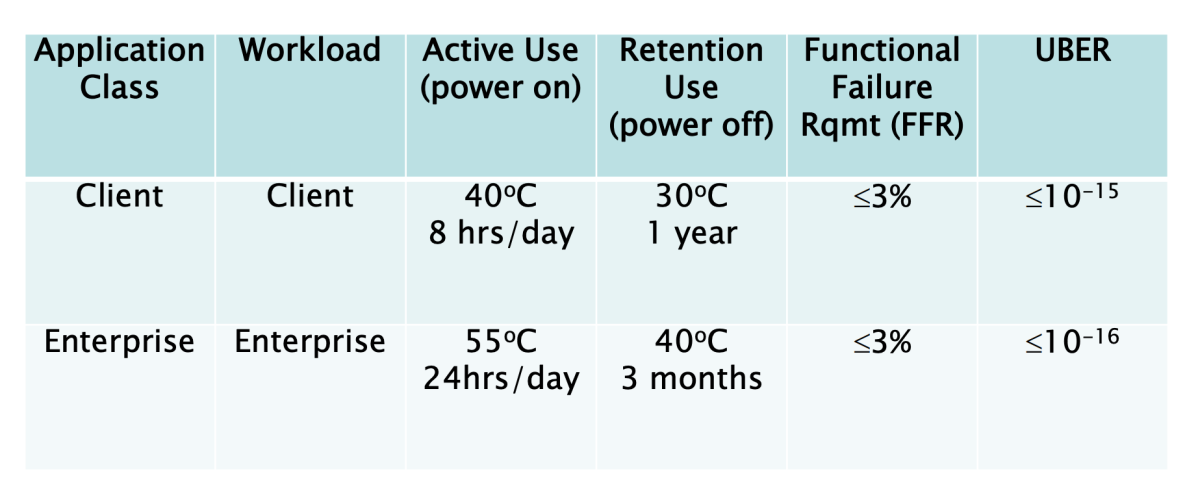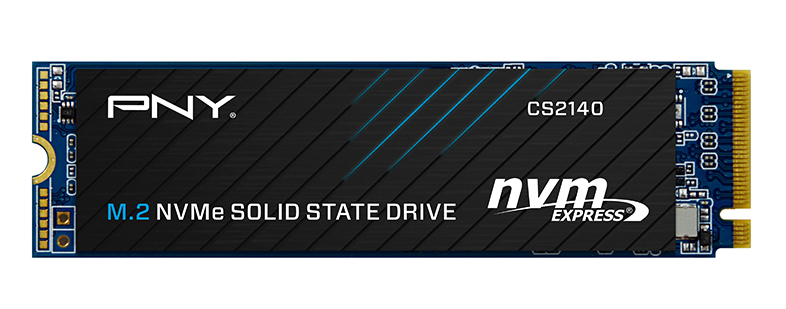There’s a reason that the Samsung 860 EVO solid-state drive shown above costs substantially less per gigabyte and carries a lower TBW (TeraBytes that can be Written) rating than the Seagate IronWolf Pro and Kingston DC500 SSDs it’s pictured with.
The latter are enterprise-class drives expected to endure far heavier workloads than the consumer-oriented (client) Samsung 860 EVO. They cost far more and for that you get reassuringly high TBW ratings and other perks. But when you’re hunting for the best SSD for you, should you worry about a particular drive’s TBW rating? Let’s dig in.
How now TBW
According to JEDEC, an industry standards organization, the criteria that should be used to calculate a TBW rating for these two different types of drives is shown in the table below.

The disparity between Client and Enterprise Workloads is similar to the time difference you see in the Active Use column–client usage involves far fewer writes than enterprise. Retention Use is basically how long data must remain readable after power is removed. Ideally, with good quality NAND, data will remain viable far longer than the time periods stated.
Functional Failure is the internal failure of the SSD for any number of reasons, and UBER is the Unrecoverable Bit Error Rate. You didn’t think electronics were perfect did you? Those very large UBER numbers indicate the fantastic number of accurate bit transactions that occur for every error.
In pure form, a TBW rating tells you roughly how much data you can write to an SSD before it runs out of extra NAND to replace worn-out blocks (Cells are grouped into pages and blocks). Yes, NAND cells have a write lifespan and SSDs have spares to take over from those that are end of life (EOL). Depending on the type of NAND in use, the generation, and the quality, end of cell life can be anywhere from a couple thousand to hundreds of thousands of write cycles.

However, not all published TBW ratings are pure—or even accurate—estimates of a drive’s lifespan. Most are the result of a complicated financial formula that of course includes expected lifespan, but also factors in pricing plus the cost of support and replacement. Why?
If a drive fails within the warranty period before its TBW rating is reached, according to most warranties, the vendor has to replace it. If it fails after surpassing the TBW rating, the vendor does not have to replace it, even if the warranty period has not lapsed.
It’s very much like your standard automotive 5-year/50,000 miles warranty. It ceases to apply when you exceed either limit. Lower TBW rating keeps prosumers and business users from buying cheaper client drives, working them to death, and then expecting them to be replaced for free.

The price premium on enterprise SSDs is much like the extended warranty retailers are always trying to sell you: More cash for more peace of mind. You might also be getting NAND from a more reliable batch or possibly a controller with better wear-leveling, i.e., spreading the writes over the NAND as evenly as possible. Free data recovery is often part of the enterprise package as well.
The odd thing is that, while you pay more for enterprise SSDs, in a way you get less. As you can see in the image of the IronWolf 110 above, enterprise drives tend to have lower capacities: 3.84TB instead of 4TB, 1.92TB instead of 2TB, etc. There isn’t less NAND, but more of it is reserved for replacing worn out blocks.
Some vendors provide utilities that allow you to adjust this “over-provisioning” for more longevity or greater capacity. Some even allow it on client drives. It’s just another part of the game.
There’s one other issue you should be aware of–how vendors handle their SSD when it hits its TBW rating.
Hard limit/soft limit
You might think that the SSD controller would simply track the state of the NAND on board and only reduce capacity or set the drive to read-only when it truly reaches EOL. This is in fact what happens in most cases, however, some vendors set the drive to read-only when the TBW number is reached. It’s a hard limit imposed regardless of the actual state of the drive.
That a vendor would do this surprised me a bit, as it might you. But at least two industry heavyweights confessed to the practice when I asked. Either the vendors are supremely confident that their ratings truly represent the limit, or they’re… Well, to be honest, I’m not sure, but if I were cynical, I’d guess lawyers are involved.
Most often, TBW is the soft limit I mentioned in the first paragraph and affects only the vendors liability to replace the drive—a more common sense approach to keep down the tech waste. Note that an SSD that’s been set to read-only retains all the data that’s been written to it. Or should (see the chart above). Retention errors are possible if rare.
One thing to remember is that even low TBW ratings represent a very large amount of data, and you likely don’t write nearly as much data as you think. Also, according the little birds I hear chirping about the industry, SSDs as a whole have proven far more reliable that even the sunniest of prognosticators predicted ten years ago.
Tempest in a teapot?
Basically, the TBW rating/warranty deal is a game rigged slightly in the house’s favor. As it should be. In the end, the average user is very unlikely to wear out even the cheapest SSD within its warranty period. Don’t worry, be happy…
If you’re a prosumer running heavy loads you can play the odds, go cheap and hope that you don’t wear out the SSD, or you can pay more in the belief that Murphy will show his ugly mug if you don’t. I’m not going to tell you which to do, but I will again reiterate that SSDs of all ilks have proven extremely robust and reliable. Then again, I use enterprise types in my NAS boxes.
If you’re really running an enterprise load, pay up. Support will be far more responsive and complete. Murphy’s a…



